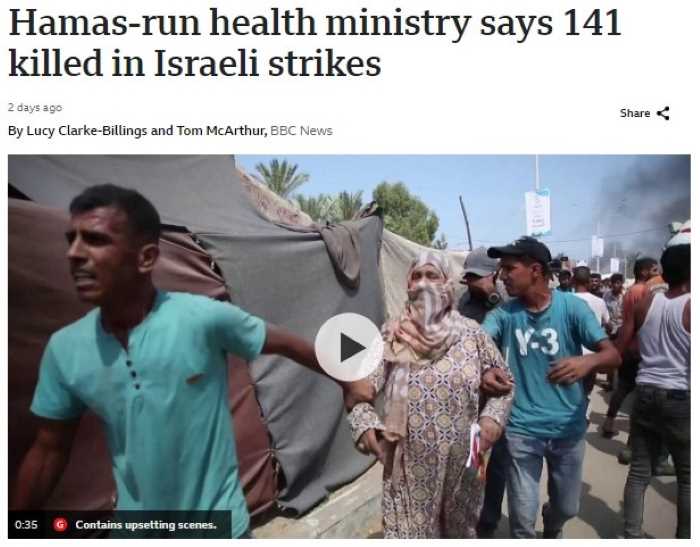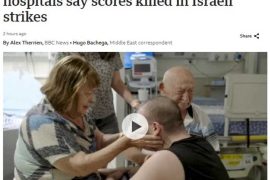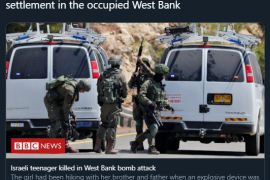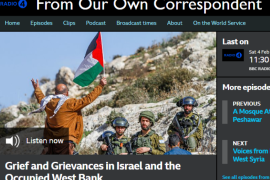Visitors to the BBC News website’s ‘Middle East’ page on the morning of July 15th found the following:
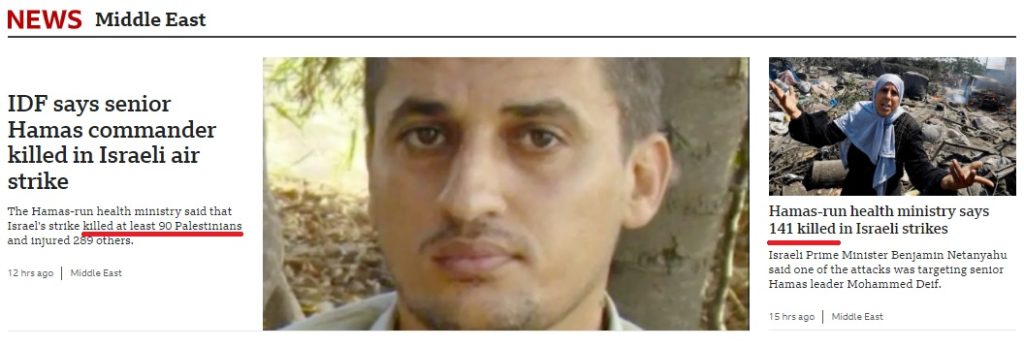
The report on the right was originally published on July 13th under the headline “At least 20 killed in air strike on Gaza humanitarian zone, Hamas says” and was credited to Rushdi Abualouf – who is located in Istanbul – and a relatively new UK-based BBC journalist called Tom McArthur.
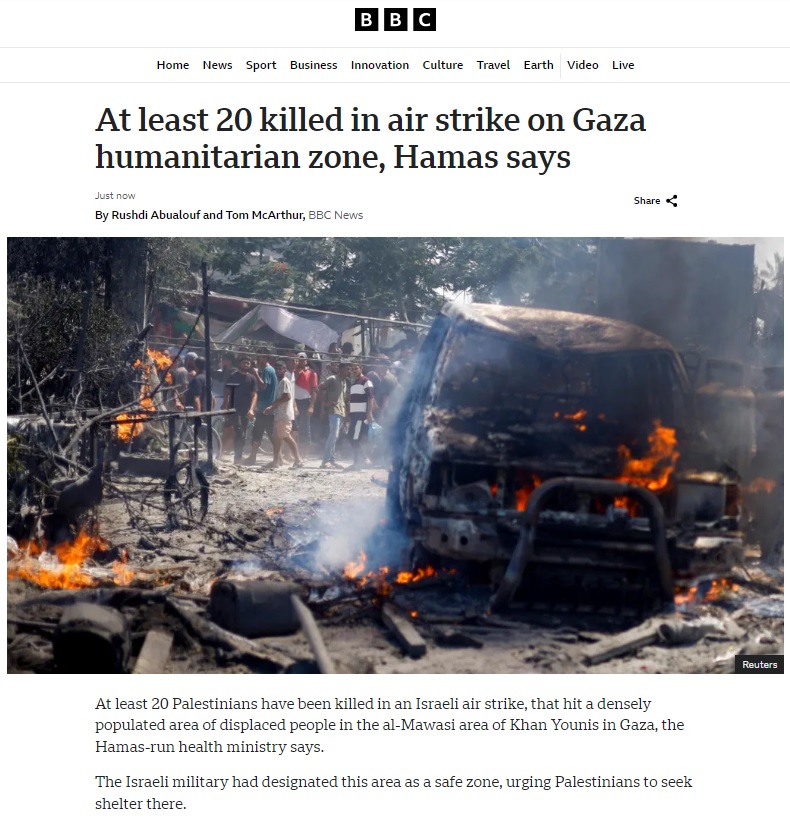
Notably, that report read more like a Hamas press release than independent, verified reporting produced by a Western media organisation. [emphasis added]
“At least 20 Palestinians have been killed in an Israeli air strike, that hit a densely populated area of displaced people in the al-Mawasi area of Khan Younis in Gaza, the Hamas-run health ministry says. […]
More than 90 people were injured in the strike, according to the health ministry’s statement. […]
A Hamas official, cited by Reuters, called the attack a “grave escalation” that showed Israel was not interested in reaching a ceasefire agreement.”
As the day went on, amendments were made to the report, including the alleged number of casualties.

The version of the report that currently appears online is titled “Hamas-run health ministry says 141 killed in Israeli strikes” and is credited to McArthur and another UK-based journalist who joined the BBC in April of this year, Lucy Clarke-Billings, with ”Additonal [sic] reporting by Rushdi Abualouf”.
That latest version of the report continues to promote claims and statements provided by the Hamas terrorist organisation which have obviously not been independently confirmed by the BBC.
“The Hamas-run health ministry in Gaza says 141 Palestinians have been killed in Israeli air strikes since Saturday.
About 400 people have been injured, according to the health ministry’s statement. […]
Gaza’s Hamas-run civil defence agency said that 17 people had been killed in a second Israeli strike on Saturday. […]
A Hamas official, cited by Reuters, called the attacks a “grave escalation” that showed Israel was not interested in reaching a ceasefire agreement. […]
Hamas leader Ismail Haniyeh, quoted by the AFP news agency, later accused Mr Netanyahu of seeking to block a ceasefire in the Gaza war with “heinous massacres”.
Hamas said the claim that their leaders were targets was “false”.
“It is not the first time Israel claims to target Palestinian leaders, only to be proven false later,” the group said in a statement.”
At no point in the report are readers told that Hamas is a proscribed terrorist organisation or that its miraculously quickly gathered casualty figures deliberately do not distinguish between civilians and combatants.
The first incident to which the report relates is the July 13th strike on a fenced-off compound in the northerly part of the al Mawasi area of the Gaza Strip where two prominent leaders of the terrorist organisation were located at the time. As reported by the Times of Israel:
“Muhammad Deif, the commander of Hamas’s military wing, and Rafa’a Salameh, the commander of Hamas’s Khan Younis Brigade, were the target of the IDF’s airstrike in the southern Gaza Strip this morning, the IDF confirms.
The pair were [in a] low building between the al-Mawasi area and Khan Younis, in a civilian environment, but not in a tent camp for displaced Palestinians.
The building was in a fenced-off Hamas compound. Several dozen more Hamas operatives were also in the area of the site when it was targeted, including guards, military sources say.”
Notably, the BBC’s reporting makes no mention of that fenced-off Hamas compound and the fact that uninvolved civilians would be unlikely to be in that closed area. Instead, the BBC preferred to paint a broad-brush picture of an attack on a “humanitarian zone”.
“One of the air strikes hit a designated humanitarian zone in the al-Mawasi area near Khan Younis. […]
BBC Verify has analysed footage of the aftermath of the strike, confirming that it took place within an area shown on the Israel Defense Forces (IDF) website as a humanitarian zone.”
The report’s sole ‘discussion’ of the issue – raised even by a Palestinian Authority official – of Hamas leaders hiding in a compound located in a designated safe zone and thereby using civilians as human shields – comes in the following paragraphs:
“An Israeli military official said the strike took place in an “open area” where there were “no civilians”.
He refused to say whether it was inside a designated safe zone, but said Hamas leaders had “cynically” set up in a civilian area.”
The latter part of the report is sub-headed “Who is Mohammed Deif?”.
“Mohammed Deif, the head of Hamas’s military wing the al-Qassam Brigades, is one of Israel’s most wanted men.”
The BBC’s report fails to inform readers that Deif has been designated by the United States since 2015.
The second incident mentioned in this report is based on claims from the much-quoted Gaza Civil Defence agency:
“Gaza’s Hamas-run civil defence agency said that 17 people had been killed in a second Israeli strike on Saturday.
The attack is said to have targeted a prayer hall in the Shati refugee camp to the west of Gaza City. The Israeli military has not yet commented on the claim.”
While there has so far been no confirmation that the incident was the result of an “Israeli strike”, it would appear that a senior member of Hamas and a convicted terrorist were among the dead.
The report pictured above on the left – “IDF says senior Hamas commander killed in Israeli air strike” – appeared on the BBC News website on July 14th and is credited to Lucy Clarke-Billings.
That report about the commander of Hamas’s Khan Younis Brigade recycles the terrorist organisation’s unverified claims used in the previous one.
“The Hamas-run health ministry in Gaza said that Israel’s strike hit a camp for displaced people in a designated humanitarian zone in Khan Younis, killing at least 90 Palestinians and injuring 289 others.
Israel has said the strike was targeting senior Hamas leaders, but Hamas says the claim is “false” and serves to “justify” the attack. […]
A Hamas official, cited by Reuters, called the attack a “grave escalation” that showed Israel was not interested in reaching a ceasefire agreement.”
The report also recycles unconfirmed statements from a doctor which appeared in the earlier article:
“Speaking to Newshour on the BBC World Service, Dr Mohammed Abu Rayya, who is at a hospital dealing with the aftermath of the attack, said the majority of those injured were suffering from multiple shrapnel wounds.
He said it was like being in “hell”, adding that many of the casualties were civilians, notably women and children.”
Once again Clarke-Billings did not question why Hamas leaders were hiding in a closed compound located within a humanitarian zone or clarify that Hamas casualty figures do not distinguish between civilians and combatants.
As we see, both these BBC reports promote Hamas claims concerning casualty numbers and breakdowns that the BBC has clearly not independently verified. Both reports also promote Hamas talking points concerning ceasefire negotiations – “A Hamas official, cited by Reuters, called the attacks a “grave escalation” that showed Israel was not interested in reaching a ceasefire agreement” – and claim that negotiations “ended on Friday without success, the BBC understands” – despite reports to the contrary.
Most significantly, both reports promote a narrative about a strike on “a camp for displaced people” while ignoring the issue of Hamas commanders hiding in a designated humanitarian zone, thereby adopting the long-standing BBC practice of ignoring the topic of Hamas’ use of human shields. That, of course, is intentional framing of the story rather than accurate and impartial reporting.
Related Articles:
MORE UNCRITICAL BBC PROMOTION OF CLAIMS FROM HAMAS-RUN CIVIL DEFENCE
FRAMING, OMISSION AND NARRATIVES IN BBC WS RADIO REPORT ON GAZA CITY

